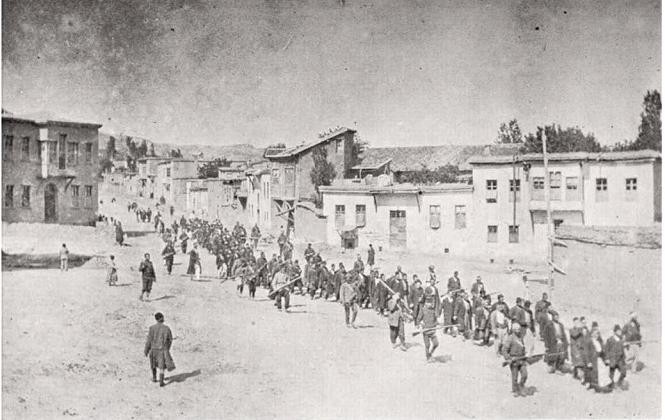Go see The Promise, a movie opening nationwide tomorrow. Hollywood has mostly ignored the Armenian genocide perpetrated by the Ottoman Turks during World War I, and subsequently pursued by the Turkish Republic. At last we have a film like The Promise, which focuses on the Armenian experience, but also the Greeks and Assyrians who were brutally victimized.
There is no uglier word in any language than genocide, which is perhaps why the word is used so sparingly. Both denotatively and connotatively the word conjures up the worst crimes against humanity – the attempted eradication of entire races, nationalities, or religions. Men, women, children. To utter the word is to open the most horrific casebook against the entirety of the human race and rocks the very foundations of our divinely designed hearts and souls.
However, hesitancy to use the word in question does us no favors. Neither does splitting hairs over whether the definition applies to one mass slaughter but not another. Whether narrowly or broadly applied, genocide is still genocide, and has happened with alarming frequency these past 100-some years. The term itself was coined in 1943 to designate the Armenian Genocide, which began in 1915. Generally acknowledged as the first genocide of the past century, the Armenian genocide claimed an estimated 1.5 million Armenian, Assyrian and Greek Christians who were systematically rounded up by the Ottoman Turks.
Ironically, while the World War I era witnessed new technological achievements in the mass slaughter of human beings on the battlefield, the Ottoman Turks resorted to the time-tested methods of firing squads, physical labor, starvation, dehydration and disease while introducing relatively new concepts in genocide: the concentration camp as well as exposure to germs and gases. The elderly, women and children who avoided immediate execution and camps were subjected barbarically to death marches through the Syrian desert (chillingly recounted in British rocker Julian Cope’s song “The Armenian Genocide”). Those who survived often were sold into sexual slavery. Churches and historical monuments were destroyed.
How best to educate en masse these historical atrocities? It never seems adequate to recite merely dates and the numbers and ages of victims. Yet the urge to express such horrors often resonates with authorial hubris. “Show, don’t tell” is a maxim for effective writing, but the effort to depict the violence and indifference to human suffering can seem calculated – in Hamlet’s words – to out-Herod Herod. Unless the writer is Aleksandr Solzhenitsyn, Elie Wiesel or other luminaries occupying the sparsely populated literary pantheon of scribes able to gut-wrenchingly depict mass cruelties, the temptation to equal or outdo their efforts invariably yields disappointing results.
Too often, as well, some attempts serve to desensitize the reader to the true magnitude of despicable human behavior by focusing too much on sadistic and sinister actions. It’s far easier to convey physical anguish than it is to render mental torture. The same theory applies equally to the visual arts as it does literature. For example, many cinematic portrayals of 20th century inhumanities could easily be stripped of their Nazi trappings and such, and wind up as generic entries in a torture-porn franchise such as the Saw series.
This, finally, brings your writer to the topic at hand – an endorsement of the new film The Promise, which avoids the pitfalls outlined above in admirable fashion. All prior reservations about viewing a film centered upon genocide were put to rest when it was revealed the movie is more about how the historical events affected the families and romantic relationships of the story’s characters. Yes, there is onscreen brutality and (brief) scenes featuring piles of discarded bodies – but such scenes are given a verite rather than a sensationalist treatment that contribute to the narrative rather than disturbingly and nauseatingly distract from it. In short, the filmmakers strike the right balance, and the $100 million budget ensures superb production values.
Credit for the film’s realism devoid of over-the-top graphic depictions is due in large part to the direction of Terry George, who cut his teeth on such films as Jim Sheridan’s The Boxer and the Bruce Willis film Hart’s War before writing and directing Hotel Rwanda, which details a more recent incident of genocide and for which he was nominated for an Academy Award for Best Original Screenplay. George directed from a compelling script he co-wrote with Robin Swicord. The lush cinematography was provided by Javier Aguirresarobe.
The Promise stars A-list actors Oscar Isaac and Christian Bale, as well as international thespians Charlotte Le Bon, Jean Reno and Shohreh Aghdashloo. Isaac portrays Michael Boghosian, a Turkish Armenian who stakes a portion of his fiancé’s dowry pursuing a medical degree in Constantinople (modern day Istanbul). Through his Turkish classmate, the son of an Ottoman general, Boghosian meets the American photojournalist Chris Myers (Bale), having already met and become smitten with Myers’ radiant female companion (Le Bon). Their ensuing love triangle is one emotional thread that weaves together the historical events of the film, echoing both the novel and film Doctor Zhivago, another love triangle set against a tumultuous historical backdrop. Another thread is Boghosian’s tight-knit family and their shared Christian devotion.
The Promise’s compacted storytelling betrays the film’s epic ambitions, which in another context would appear to be a negative assessment. On the contrary, one measure of art’s quality is the recipient’s desire for more than is delivered and, such is the richness of the story’s tapestry and the fullness of even the most minor characters, this is a high compliment indeed. In fact, the film’s running length underscores the tragedy of the massive number of Armenian, Greek and Assyrian lives abbreviated horrifically during the first genocide of the modern era. The Promise is highly recommended.
